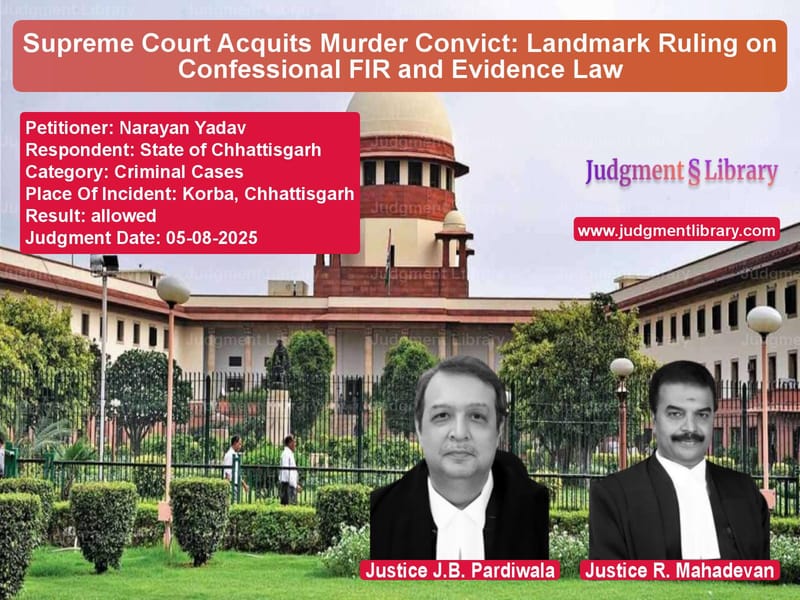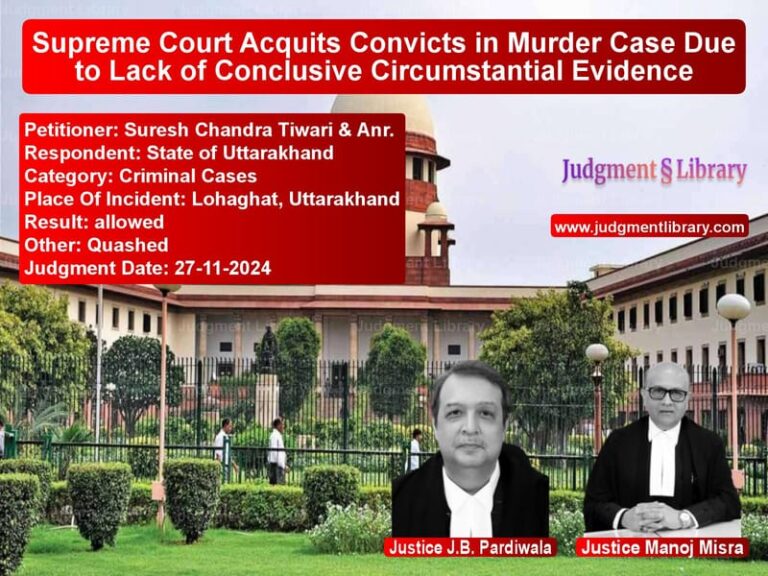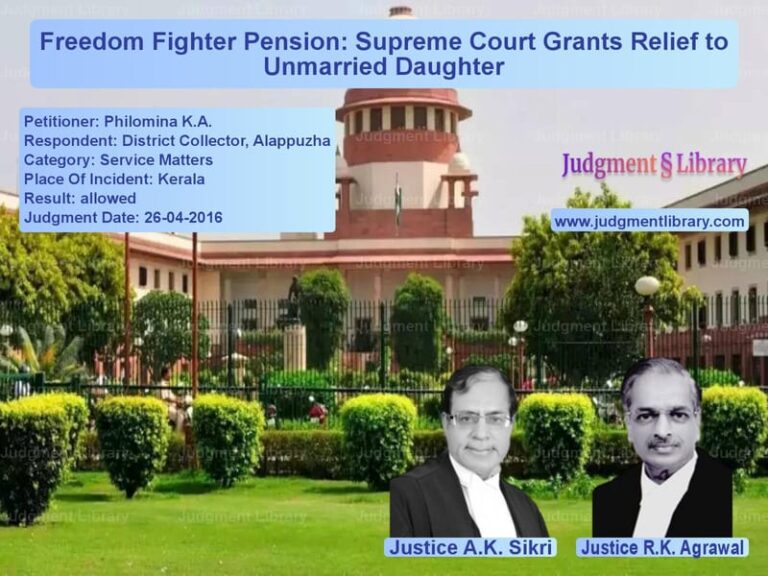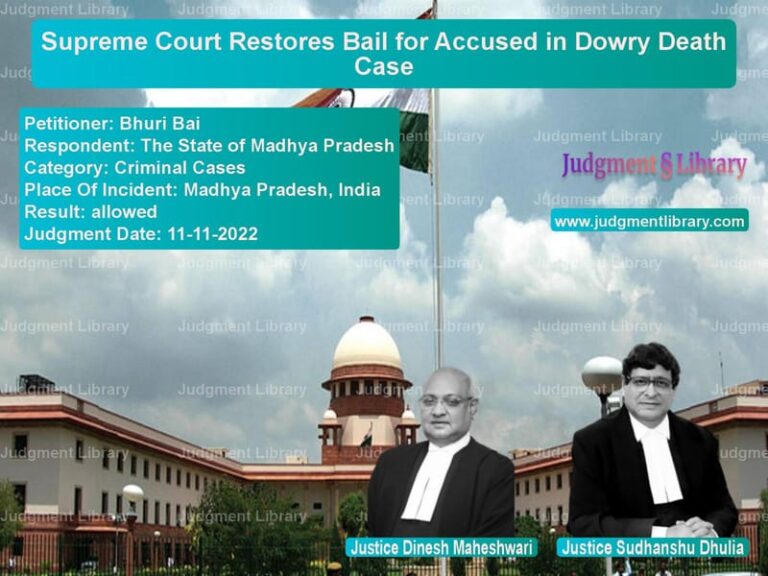Supreme Court Acquits Murder Convict: Landmark Ruling on Confessional FIR and Evidence Law
In a landmark judgment that reinforces fundamental principles of criminal jurisprudence, the Supreme Court of India has acquitted Narayan Yadav, who was convicted for the murder of Ram Babu Sharma in 2019. The case, which traveled through multiple judicial forums over six years, culminated in a comprehensive ruling that clarifies several crucial aspects of evidence law, particularly regarding confessional statements made to police officers and the proper evaluation of expert testimony.
The judgment delivered by Justice J.B. Pardiwala and Justice R. Mahadevan on August 5, 2025, sets aside the conviction imposed by both the Trial Court and the Chhattisgarh High Court, highlighting serious legal errors in the appreciation of evidence. The case originated from an incident on September 24, 2019, when Narayan Yadav and the deceased were drinking together at Sharma’s residence in Korba, Chhattisgarh.
The Case Background
The peculiar aspect of this case was that the appellant himself lodged the First Information Report (FIR) with Korba Kotwali Police Station on September 27, 2019. In his FIR, Yadav stated that he had gone to Sharma’s house after being invited for drinks. During their conversation, Yadav showed Sharma a photograph of his girlfriend on his mobile phone. According to the FIR, Sharma then made an inappropriate remark: “get your girlfriend at my place and leave her with me for one night.”
This allegedly led to a quarrel between them. The FIR further stated: “Then I picked up a knife kept in his house for cutting vegetables and inflicted blows on his neck and stomach in anger and killed him by hitting a log of wood on his head, legs and private part.” After the incident, Yadav allegedly took Rs. 7,000 from Sharma’s purse and keys to his Bolero car, which he used to drive towards Bilaspur. He met with an accident on the way and was hospitalized before eventually reporting the incident to police.
The prosecution case relied heavily on this FIR, along with medical evidence and recovery of evidence. The post-mortem examination conducted by Dr. R.K. Divya (PW-10) recorded six incised wounds on the deceased’s body, with the cause of death being shock resulting from excessive bleeding from the right side of the chest and injury to the upper lobe of the right lung.
The Legal Journey
The Trial Court convicted Yadav under Section 302 of the Indian Penal Code (murder) and sentenced him to life imprisonment. On appeal, the Chhattisgarh High Court partly allowed the appeal and altered the conviction from Section 302 to Section 304 Part I of IPC (culpable homicide not amounting to murder), giving him the benefit of Exception 4 to Section 300 of IPC.
The High Court had observed: “Reverting to the facts of the present case, in light of principles of law laid down by their Lordships of the Supreme Court in the above stated judgments, it is quite vivid that the appellant himself has lodged a First Information Report alleging that, on the date of incident, some quarrel took place between the appellant and the deceased on the ground of showing the photograph of his girlfriend to the deceased and the deceased stated to bring his girlfriend and left her with him for one night, then out of anger and on sudden quarrel, the appellant assaulted the deceased with a knife on his chest.”
However, the Supreme Court found multiple fundamental errors in this approach, leading to the complete acquittal of the appellant.
The Supreme Court’s Analysis
The Supreme Court identified four major areas where the lower courts had erred: the admissibility of confessional FIR, the nature of expert evidence, the application of Sections 27 and 8 of the Evidence Act, and the incorrect application of Exception 4 to Section 300 of IPC.
On the crucial issue of the confessional FIR, the Court delivered significant observations that reinforce the protections afforded to accused persons under Indian evidence law. The Court stated: “A first information report is not a substantive piece of evidence and can only be used to corroborate the statement of the maker under Section 157, Evidence Act, or to contradict it under Section 145 of that Act. It cannot be used as evidence against the maker at the trial if he himself becomes an accused, nor to corroborate or contradict other witnesses.”
The judgment extensively referred to precedent cases, particularly Faddi v. State of M.P. (1964) and Aghnoo Nagesia v. State of Bihar (1965), to establish that a confessional FIR cannot be used against the accused. The Court explained: “The legal position, therefore, is this – a statement contained in the FIR furnished by one of the accused in the case cannot, in any manner, be used against another accused. Even as against the accused who made it, the statement cannot be used if it is inculpatory in nature nor can it be used for the purpose of corroboration or contradiction unless its maker offers himself as a witness in the trial.”
The Court further elaborated: “If the FIR given by the accused contains any admission as defined in Section 17 of the Evidence Act there is no bar in using such an admission against the maker thereof as permitted under Section 21 of the Act, provided such admission is not incubatory in character.” However, in this case, the Court found the FIR to be clearly confessional in nature and therefore inadmissible.
Expert Evidence and Its Limitations
The Supreme Court also addressed the improper reliance on medical evidence by the High Court. The Court observed: “The High Court should have been mindful of the fact that a doctor is not a witness of fact. A doctor is examined by the prosecution as a medical expert for the purpose of proving the contents of the post-mortem report and the medical certificates on record, if any. An expert witness is examined by the prosecution because of his specialized knowledge on certain subjects, which the judge may not be fully equipped to assess. The evidence of such an expert is of an advisory character.”
The Court emphasized that “An accused cannot be held guilty of the offence of murder solely on the basis of medical evidence on record.” This observation is particularly significant in cases where medical evidence is often given disproportionate weight compared to other forms of evidence.
Problems with Witness Testimony
The Supreme Court noted that most panch witnesses had turned hostile during the trial. The Court stated: “If at all, the public prosecutor wanted to prove the contents of the panchnamas after the panch witnesses turned hostile, he could have done so through the evidence of the investigating officer. However, the investigating officer also failed to prove the contents of the panchnamas in accordance with law.”
This failure to properly establish the chain of evidence further weakened the prosecution’s case. The Court found that “no discovery of fact at the instance of the appellant, relevant and admissible under Section 27 of the Act of 1872, has been established.”
Incorrect Application of Exception 4
Although the Supreme Court had already decided to acquit the appellant due to lack of admissible evidence, it nevertheless addressed the High Court’s erroneous application of Exception 4 to Section 300 of IPC. The Court explained: “To bring a case within Exception 4, all the ingredients mentioned therein must be satisfied. It is important to note that the term ‘fight’ occurring in Exception 4 to Section 300 of the IPC is not defined in the IPC. A fight necessarily involves two parties – it takes two to make a fight.”
The Court further elaborated on the requirements of Exception 4: “The protection of Exception 4 may be invoked if death is caused: (a) without premeditation; (b) in a sudden fight; (c) without the offender having taken undue advantage or acted in a cruel or unusual manner; and (d) the fight must have been with the deceased.”
In this case, the Court found that the deceased was unarmed and that the appellant had inflicted multiple injuries, indicating that he had taken undue advantage. The Court observed: “The deceased was unarmed, it was not mutual fight between two individuals that would bring the case within the ambit of Exception 4. The deceased was absolutely harmless when the appellant inflicted injuries all over his body indiscriminately.”
Acquittal and Broader Implications
In its concluding remarks, the Supreme Court stated: “In the overall view of the matter, we are convinced that the Impugned Judgement passed by the High Court of Chhattisgarh in Criminal Appeal No. 1538 of 2021 dated 16.01.2025 is not sustainable in law. In the result, this appeal succeeds and is hereby allowed. The appellant is acquitted of all the charges, and he be set free forthwith if not required in any other case.”
The Court also directed that “The Registry shall circulate one copy each of this judgment to all the High Courts,” indicating the precedent-setting nature of this ruling.
This judgment serves as a significant reminder of the fundamental principles of criminal jurisprudence, particularly the protections against self-incrimination and the proper evaluation of different types of evidence. It reinforces that convictions cannot be based solely on confessions made to police officers or expert testimony without proper corroboration through legally admissible evidence. The ruling underscores the judiciary’s commitment to ensuring that convictions are based on solid legal foundations rather than procedural errors or improper appreciation of evidence.
Petitioner Name: Narayan Yadav.Respondent Name: State of Chhattisgarh.Judgment By: Justice J.B. Pardiwala, Justice R. Mahadevan.Place Of Incident: Korba, Chhattisgarh.Judgment Date: 05-08-2025.Result: allowed.
Don’t miss out on the full details! Download the complete judgment in PDF format below and gain valuable insights instantly!
Download Judgment: narayan-yadav-vs-state-of-chhattisgar-supreme-court-of-india-judgment-dated-05-08-2025.pdf
Directly Download Judgment: Directly download this Judgment
See all petitions in Murder Cases
See all petitions in Bail and Anticipatory Bail
See all petitions in Fraud and Forgery
See all petitions in Custodial Deaths and Police Misconduct
See all petitions in Legal Malpractice
See all petitions in Judgment by J.B. Pardiwala
See all petitions in Judgment by R. Mahadevan
See all petitions in allowed
See all petitions in supreme court of India judgments August 2025
See all petitions in 2025 judgments
See all posts in Criminal Cases Category
See all allowed petitions in Criminal Cases Category
See all Dismissed petitions in Criminal Cases Category
See all partially allowed petitions in Criminal Cases Category







